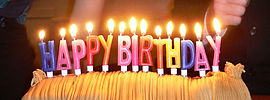හැපි බර්ත්ඩේ ටු යූ
Lua දෝෂය in Module:Effective_protection_level at line 16: attempt to index field 'FlaggedRevs' (a nil value).
| "Happy Birthday to You" | |
|---|---|
 | |
| ගීතය | |
| භාෂාව | ඉංග්රීසි |
| ප්රකාශයට පත්කළේ | 1893 |
| ගීතරචක(යන්) | පැටි හිල් මිඩ්රඩ් ජේ. හිල් |
"Happy Birthday to You" යනු පුද්ගලයකු ගේ උපන්දින (උත්සව)යක දී සාම්ප්රදායික ව ගායනා කරනු ලබන ගීයකි. 1998 ගිනස් ලෝක වාර්තා වලට අනුව ලොව වඩාත් ම ප්රචලිත ඉංග්රීසි ගීතය මෙය යි. මෙය ට දෙවැනි වන්නේ For He's a Jolly Good Fellow යන ගීතය යි. මෙම ගීතයේ මුලික පදමාලාව අඩු තරමින් භාෂා 18කට වත් පරිවර්තනය වී ඇත.[1] මතභේදයට තුඩුදී ඇති වුවත් "Happy Birthday to You" ගීතයේ තනුව නිර්මාණය වී ඇත්තේ ඇමරිකානු සහෝදරියන් දෙපළක් වන පැටි හිල් සහ මිල්ඩ්රඩ් ජේ. හිල් විසින් 1893 දී රචිත "Good Morning to All" යන ගීතය ට අනුව බව පිළිගැනේ.[2] [3][4] [5]
පදමාලාව
[සංස්කරණය]"Happy birthday to you"
[සංස්කරණය]- Happy birthday to you,
- Happy birthday to you,
- Happy birthday, dear John,
- Happy birthday to you.[6]
Lyrics with the melody
[සංස්කරණය]
Traditions
[සංස්කරණය]It is traditional, among English-speakers, that at a birthday party, the song "Happy Birthday to You" be sung to the birthday person by the other guests celebrating the birthday. More specifically, the birthday person is traditionally presented with a birthday cake with lit candles, with the number of candles sometimes corresponding to the age of the person. After the song is sung (usually just once), party guests sometimes add wishes like "and many more!" expressing the hope that the birthday person will enjoy a long life. The birthday person may be asked to make a wish ("Make a wish!")—which he or she does silently—and then is supposed to blow out the candles. Traditionally, blowing out of the candles is believed (or is considered a lighthearted superstition) to ensure that the wish will come true.[7] Once the candles have been blown out, people may applaud, after which the cake may be served, often with the first piece being served to the person whose birthday it is.
In Australia, the United Kingdom, New Zealand and Ireland, immediately after "Happy Birthday" has been sung, it is traditional for one of the guests to enthusiastically lead with "Hip hip..." and then for all of the other guests to join in and say "...hooray!" This is normally repeated three times.
- ^ Brauneis (2010), p. 17.
- ^ Hill;, Mildred J. (music); Hill, Patty S. (lyrics) (1896). "Good Morning to All". Song Stories for the Kindergarten. Illustrations by Margaret Byers; With an introduction by Anna E. Bryan (New, Revised, Illustrated and Enlarged ed.). Chicago: Clayton F. Summy Co. p. 3.
{{cite book}}: CS1 maint: extra punctuation (link) CS1 maint: multiple names: authors list (link) - ^ Collins, Paul (ජූලි 21, 2011). "You Say It's Your Birthday. Does the Infamous 'Happy Birthday to You' Copyright Hold up to Scrutiny?". Slate. සම්ප්රවේශය අගෝස්තු 9, 2011.
- ^ Originally published in Song Stories for the Kindergarten. Chicago: Clayton E. Summy Co. 1896. as cited by Snyder, Agnes (1972). Dauntless Women in Childhood Education, 1856–1931. Washington, D.C.: Association for Childhood Education International. p. 244.
- ^ Masnick, Mike (ජූනි 13, 2013). "Lawsuit Filed to Prove Happy Birthday Is in The Public Domain; Demands Warner Pay Back Millions of License Fees". Techdirt.com.
- ^ Alice Jacobs (1911). The Elementary Worker and His Work. Sunday Schools. p. 63. සම්ප්රවේශය සැප්තැම්බර් 23, 2015.
- ^ Konstantinides, Anneta (මැයි 12, 2015). "That's Not What She Wished For! Grandma, 102, Blows Out Her Birthday Candles... and Ends Up Losing Her Teeth Instead". The Daily Mail. London. සම්ප්රවේශය සැප්තැම්බර් 23, 2015.
